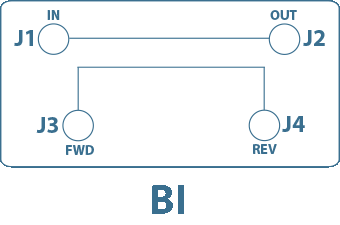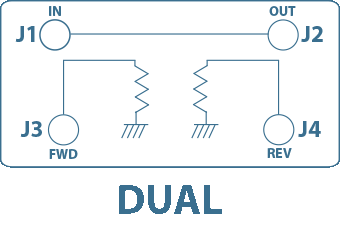Selecting Optimum Dual Directional Couplers
Directional couplers are passive electronic components that are useful for performing measurements in many practical systems, particularly in the field of radio frequency and microwave engineering. One of the primary uses of a directional coupler is to sample a signal without disturbing the primary circuit. Directional couplers can also be used to sample a signal for monitoring or feedback, combine feeds in antenna systems, and to tap signals in a cable distributed or in-building distributed antenna system.
A directional coupler couples a fixed amount of electromagnetic energy from a main line onto a secondary line. One method of coupling electromagnetic energy is to place a secondary line in close proximity to the main line. The coupling factor is the amount of energy coupled to the secondary line and it can be controlled by the physical distance between the two lines. Another method is to use lumped-elements to couple energy from the main line to the secondary line. The lumped element approach is most useful at lower frequencies and the coupled transmission line approach is most useful at high frequencies. The equation for coupling factor is shown below where Cdb is the coupling factor in dB, Pc is the power coupled to the secondary transmission line and Pin is the incident power on the main line.

Any coupling value can be obtained through proper electronic design, but devices with C values of 3, 6, 10, 20, 30, 40 and 50 dB are industry standards.
A Bi-Directional Coupler consists of a main line and a coupled line. Both ends of the coupled line serve as coupled ports. A Bi-Directional design simultaneously monitors both forward and reverse power. The directivity of this design is, however, dependent upon well matched 50 Ohm loads on the coupled ports. A diagram in shown below.

Dual directional couplers are created by connecting two bi-directional couplers back-to-back with a common main transmission line and internal resistors to terminate the coupled lines. This configuration results in both a forward coupled port and a reverse coupled port which have high signal isolation between them. The high signal isolation is critical for measuring forward and reverse power accurately. A diagram is shown below.

The magnitude of the output signal of dual directional couplers should be equal to the magnitude at the input port minus the magnitude of the signal sampled by the coupler. An ideal directional coupler samples only a signal that is transmitted in a single direction. Signals reflected from the output port are not introduced into the secondary transmission line. In practice, however, a small amount of backward signal is always coupled to the secondary line 180 degrees out of phase from the incident signal. This results in the cancellation of a small portion of the incident wave and introduces uncertainty into the measurement.
A primary figure of merit for directional couplers is directivity. Directivity refers to how well the coupler can separate the main forward signal from any reverse signals travelling on the main transmission line.
![]()
An ideal dual directional coupler possesses infinite directivity and will not have measurement uncertainty. This results in perfectly accurate power measurement at the forward and reverse ports. In practical use, as directivity worsens, the amount of measurement uncertainty increases because a small amount of reverse power couples to the forward port. For a practical example, consider a 40 dB dual directional coupler with 40 dB directivity installed in a network with a 1.5:1 VSWR. This coupler will have a forward power measurement error range between -0.4% and 0.4%. The reverse power error range will be -10% to 10%. A less accurate coupler with directivity of 20 dB will have a forward power error range of -4% and 4% and a reverse power error range of -62% and 90% [1].
Another figure of merit for directional couplers is their Voltage Standing Wave Ratio (VSWR). Reflections occur on a transmission line terminated with a different impedance than the characteristic impedance of the transmission line. The reflected signal adds constructively and destructively with the forward signal resulting in a composite signal. This composite signal will have voltage maxima and minima. VSWR is a scalar measurement and is the ratio of the signal maxima to the minima. A perfectly matched transmission line will have a VSWR of 1:1. An open or a short circuit has a VSWR of infinity. One of the primary goals of a directional coupler is not to disturb the original signal and a directional coupler with the lowest VSWR will result in minimum disturbance to the main line signal.
Insertion loss is another figure of merit in directional couplers because the primary goal of the directional coupler is to accurately sample without disturbing the main line. Power at RF and microwave frequencies is expensive to generate and system designers prefer components with the least possible insertion loss.
Perhaps the most unique features of many Werlatone Directional Couplers is the ability to operate in the most extreme environmental and electronic environments. Many of Werlatone directional couplers are labeled Mismatch Tolerant® because they have been designed to survive systems that have an infinite VSWR. These components can tolerate a full mismatch at rated power without failing. They feature exceptional directivity and VSWR, and are approved for use in military and EMC testing environments.
References:
[1] Straight Talk About Directivity, Jim Norton. www.bird-electronic.com
